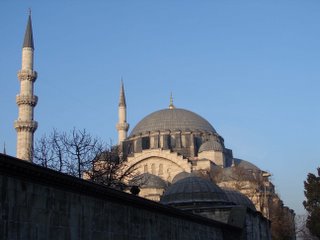Suleymaniye Camii
The Suleiman Mosque was built on the order of sultan Suleiman the Magnificent and constructed by the great Ottoman architect Sinan. The construction work began in 1550 and the mosque was finished in 1557.
The mosque is modeled in part on the style of a Byzantine basilica, particularly the Hagia Sophia, which was perhaps a conscious move on the part of the sultan to create a continuity and a symbolic connection with the city's past.
The Suleiman Mosque was ravaged by a fire in 1660 and was restored on the command of sultan Mehmed IV by architect Fossatı. The restoration, however, changed the mosque into a more baroque style, damaging the great work severely.
The mosque was restored to its original glory during the 19th century but during World War I the courtyard was used as a weapons depot and when some of the ammunition ignited, the mosque suffered another fire. Not until 1956 was it restored again. Today, the Suleiman Mosque is one of the most popular sights in Istanbul.
The mosque is 59 meters in length and 58 meters in width. The main dome is 53 meters high and has a diameter of 27.25 meters. Apart from the main mosque with the prayer hall (cami) and courtyard (avlu), the mosque complex also includes a caravanserai or seraglio (sarayı; han), a public kitchen (imaret) which served food to the poor, a hospital (darüşşifa), a Qur'an school (medrese) and a bath-house (hamam).
In the garden behind the main mosque there are two mausoleums (türbe) including the tombs of sultan Suleiman I, his wife Roxelana (Haseki Hürrem), his daughter Mihrimah, his mother Dilaşub Saliha and his sister Asiye. Suleiman's tomb features a system of layered domes copied from the Dome of the Rock in Jerusalem.
The sultans Suleiman II, Ahmed II and Safiye (died in 1777), the daughter of Mustafa II, are also buried here. Just outside the mosque walls to the north is the humble tomb of Sinan, designed by the occupant himself.







Street painting, on the way between the Suleymaiye Cammi and the Beyazit Camii.

Beyazit Camii
Located by the entrance to Istanbul's university, it is of the oldest mosques in the city and the oldest surviving imperial mosque.
The Beyazit Camii was built between 1501 and 1506 using materials taken from Theodosius's Forum of Tauri, on top of which it was constructed.
Again, the architect of Beyazit Camii looked to the Ayasofya for inspiration, employing a central dome buttressed by semi-domes and a long nave with double arcades, although the mosque is half the size of the church.
The Beyazit Mosque also borrows elements from the Fatih Mosque, imitating the system of buttressing and the use of great columns alongside the dome.
Thanks to Sultan Beyazit II's patronage, the Ottomans found a style of their own, which served as a bridge to later classical Ottoman architecture. The sultan, who died in 1512, is buried at the back of the gardens.

A seller in the Book Bazaar, who seems to be a character from one of The Lord of The Rings movies.

Information: Sacred Destinations.
1 comment:
As fotos tao msm altamnt!!!!
Que sonho....
To a morrer d saudds tuas... Alias eu e td o pessoal!!!
Ja descobri que um colega meu conhece a amiga que foi ctg!!! :)
Tb ja descobri qd vens!! :))
Bejinhos****
Post a Comment